Chapter: Operations Research: An Introduction : Modeling with Linear Programming
Selected LP Applications: Currency Arbitrage
SELECTED LP APPLICATIONS
This section presents realistic LP models in which the definition of the variables and the construction of the objective function and constraints are not as straight-forward as in the case of the two-variable model. The areas covered by these appli-cations include the following:
1. Urban planning.
2. Currency arbitrage.
3. Investment.
4. Production planning and inventory control.
5. Blending and oil refining.
6. Manpower planning.
Each model is fully developed and its optimum solution is analyzed and interpreted.
2. Currency Arbitrage
In
today's global economy, a multinational company must deal with currencies of
the countries in which it operates. Currency arbitrage, or simultaneous
purchase and sale of currencies in different markets, offers opportunities for
advantageous movement of money from one currency to another. For example,
converting £1000 to U.S. dollars in 2001 with an exchange rate of $1.60 to £1 will yield $1600. Another way of
making the conversion is to first change the British pound to Japanese yen and
then convert the yen to U.S. dollars using the 2001 exchange rates of £1 = ¥175 and
$1 = ¥105. The resulting dollar
amount is (£1,000x¥175) / ¥105 = $ 1,666,.67. This
example demonstrates the advantage of converting the British money first to
Japanese yen and then to dollars. This section shows how the arbitrage problem
involving many currencies can be formulated and solved as a linear program.
Example
2.3-2 (Currency
Arbitrage Model)
Suppose
that a company has a total of 5 million dollars that can be exchanged for euros
(€), British pounds (£), yen (¥), and Kuwaiti dinars (KD). Currency dealers set
the following limits on the amount of any single transaction: 5 million
dollars, 3 million euros, 3.5 million pounds, 100 million yen, and 2.8 million
KDs. The table below provides typical spot exchange rates. The bottom diagonal
rates are the reciprocal of the top diagonal rates. For example, rate(€→ $) = l/rate(
$ → €) = 1/.769 = 1.30.

Is it
possible to increase the dollar holdings (above the initial $5 million) by
circulating currencies through the currency market?
Mathematical Model: The
situation starts with $5 million. This amount goes through a number of conversions to other currencies before
ultimately being reconverted to dollars. The problem thus seeks determining the
amount of each conversion that will maximize the total dollar holdings.
For the
purpose of developing the model and simplifying the notation, the following
nu-meric code is used to represent the currencies.

Define
xij = Amount
in currency i converted to currency j, i and j
= 1,2, ... ,5
For example,
x12 is the dollar amount converted
to euros and x51 is the KD amount converted to
dollars. We further define two additional variables representing the input and
the output of the arbitrage problem:
I = Initial dollar amount (= $5
million)
y = Final dollar holdings (to be determined from the solution)
Our goal
is to determine the maximum final dollar holdings, y, subject to the currency flow restrictions and the maximum limits
allowed for the different transactions.

Definition
of the input/output variable, x13, between $ and £
We start
by developing the constraints of the model. Figure 2.4 demonstrates the idea of
converting dollars to pounds. The dollar amount xI3 at originating currency 1 is
converted to 625xl3 pounds at
end currency 3.At the same time, the transacted dollar amount cannot exceed the limit
set by the dealer, x13 ≤ 5.
To
conserve the flow of money from one currency to another, each currency must
satisfy the following input-output equation:
( Total
sum available of a currency (input) ) = ( Total sum converted to other
currencies (output) )
1. Dollar (i = 1):
Total
available dollars = Initial dollar amount +
dollar
amount from other currencies

Total
distributed dollars = Final dollar holdings +
dollar
amount to other currencies

Given I = 5, the
dollar constraint thus becomes
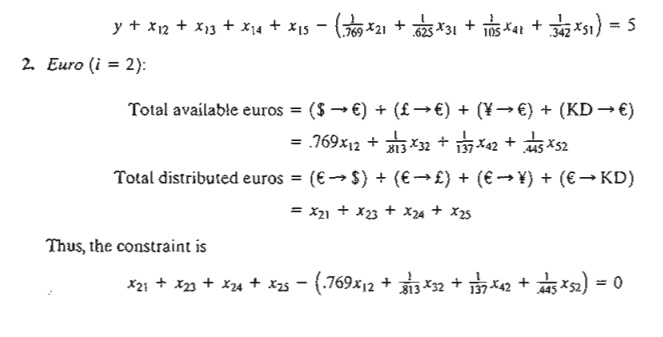
3. Pound (i = 3):
Total
available pounds = ($ -→ £) + (€→ £) + (¥→ £) + (KD → £)

Total
distributed pounds = (£→ $) + (£→ €) + (£→ ¥) + (£→ KD)
= x31
+ x32 +x34 + x35
Thus, the ,constraint is
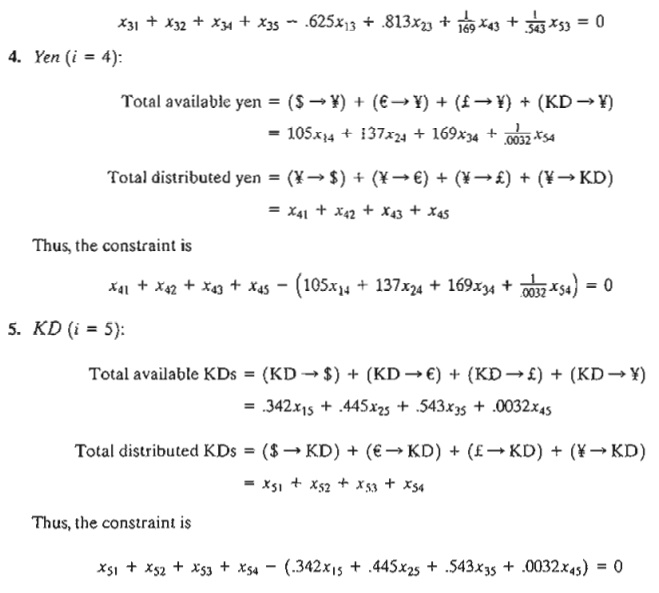
The only remaining constraints are the transaction limits, which are 5 million dollars, 3 million euros,3.5 million pounds, 100 million yen, and 2.8 million KDs. These can be translated as
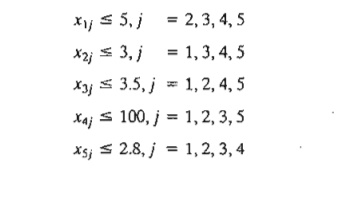
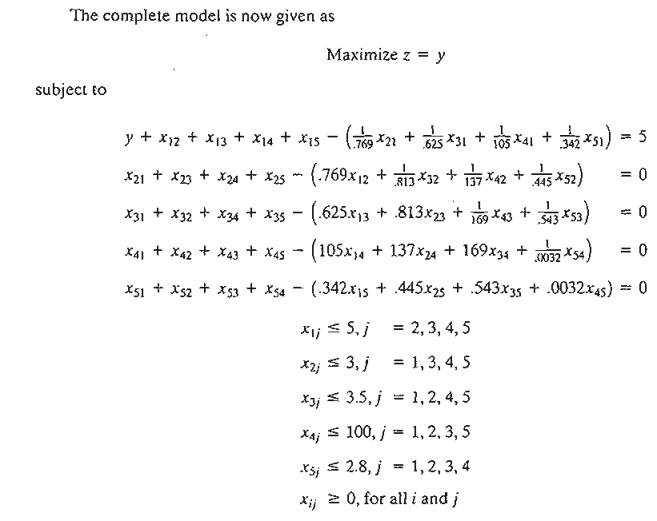
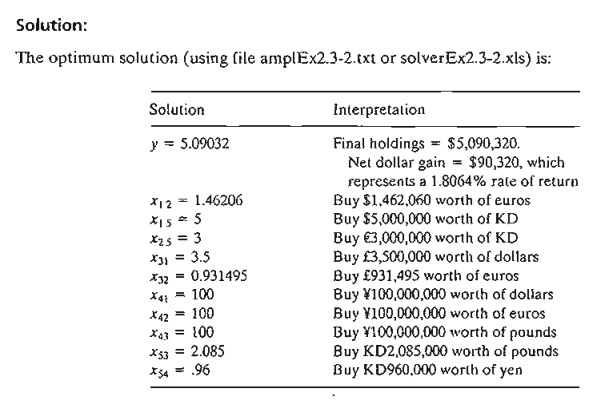
Remacks. At first it may appear that the
solution is nonsensical because it calls for using xl2 + x15
= 1.46206 + 5 = 6.46206,
or $6,462,060 to buy euros and KDs when the initial dollar amount is
only $5,000,000. Where do the extra dollars come from? What happens in practice
is that the given solution is submitted to the currency dealer as one order, meaning we do not wait until
we accumulate enough currency of a certain type before making a buy. In the
end, the net result of all these transactions is a net cost of $5,000,000 to
the investor. This can be seen by sum-ming up all the dollar transactions in
the solution:

Notice
that x21,
x31 , x41 and x51 are in euro, pound, yen, and KD,
respectively, and hence must be converted to dollars.
PROBLEM
SET 2.3B
1. Modify
the arbitrage model to account for a commission that amounts to.1 % of any currency
buy. Assume that the commission does not affect the circulating funds and that
it is collected after the entire order is executed. How does the solution
compare with that of the original model?
2. Suppose
that the company is willing to convert the initial $5 million to any other
currency that will provide the highest rate of return. Modify the original
model to determine which currency is the best.
3. Suppose
the initial amount I = $7 million and that the
company wants to convert it optimally to a combination of euros, pounds, and
yen. TIle final mix may not include more than €2 million, £3 million, and ¥200
million. Modify the original model to determine the optimal buying mix of the
three currencies.
4. Suppose
that the company wishes to buy $6 million. The transaction limits for different
currencies are the same as in the original problem. Devise a buying schedule
for this trans-action, given that mix may not include more than €3 million, £2
million, and KD2 million.
5. Suppose
that the company has $2 million, £5 million, £4 million. Devise a buy-sell
order that will improve the overall holdings converted to yen.
Related Topics